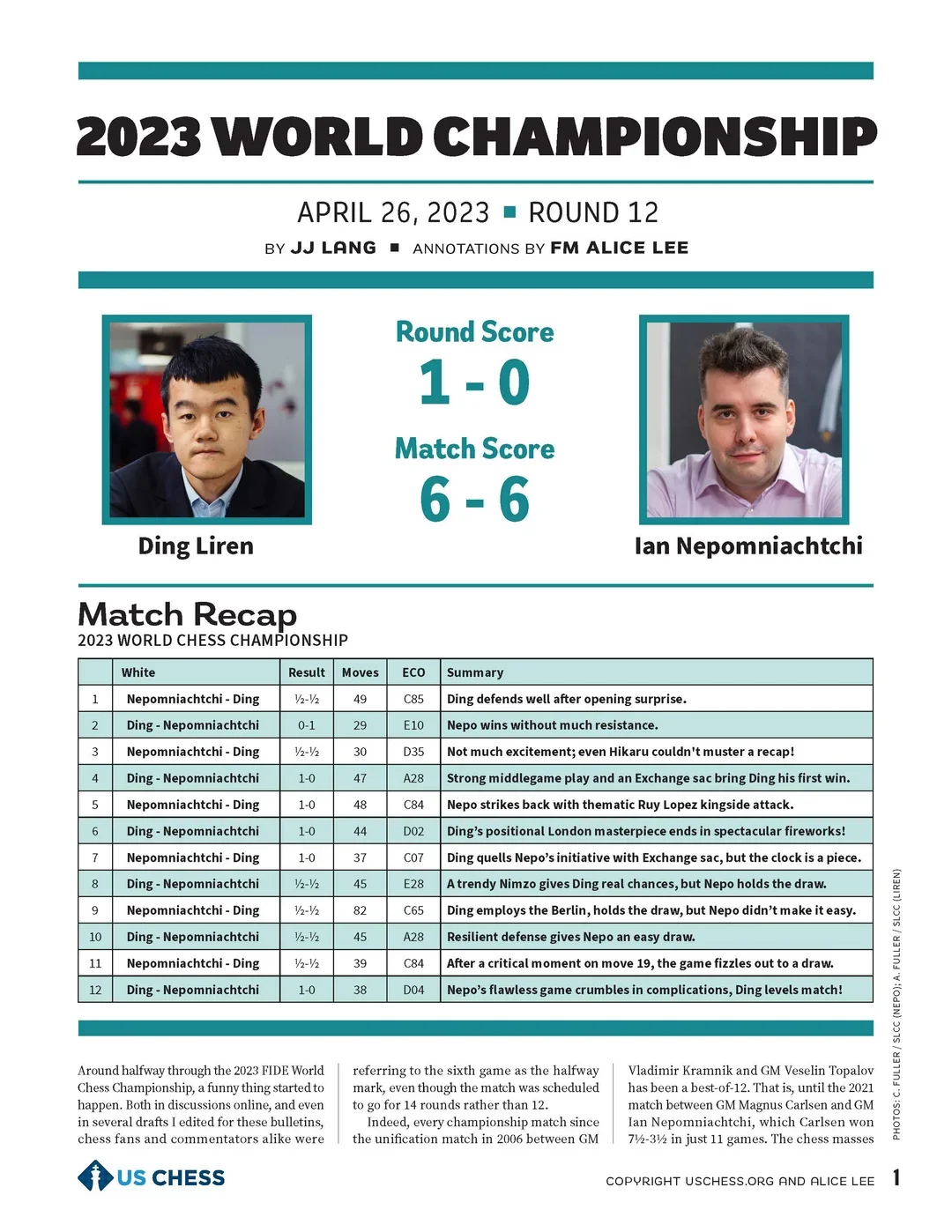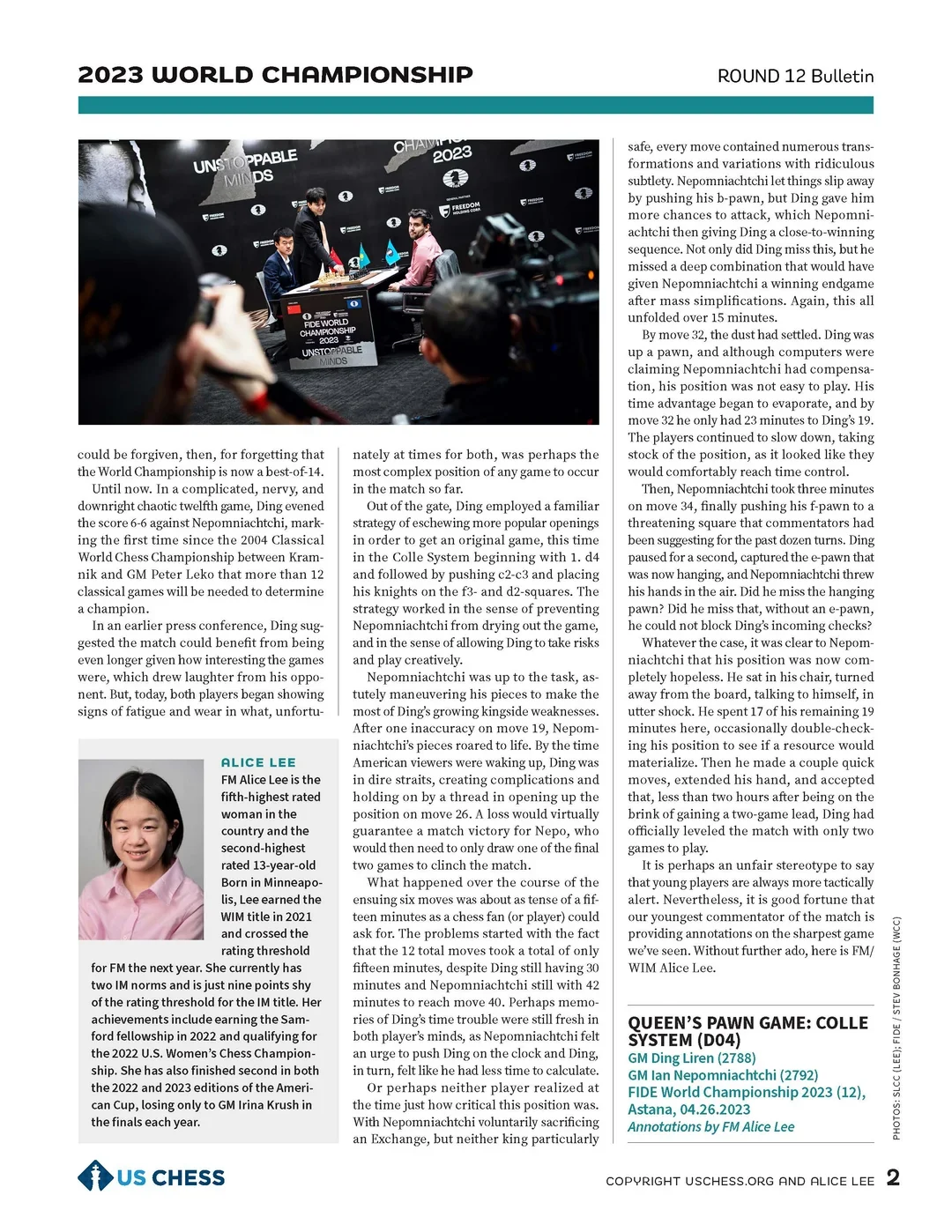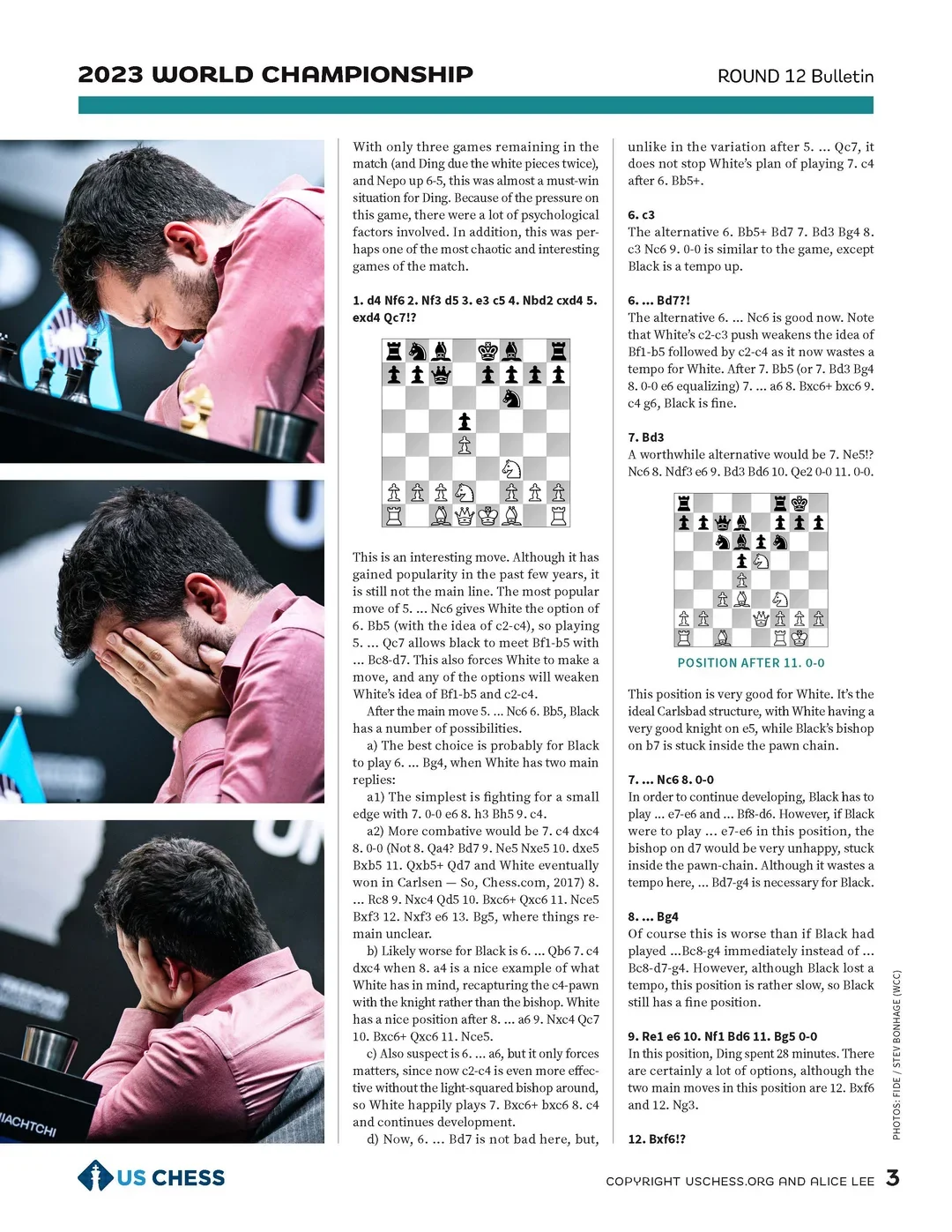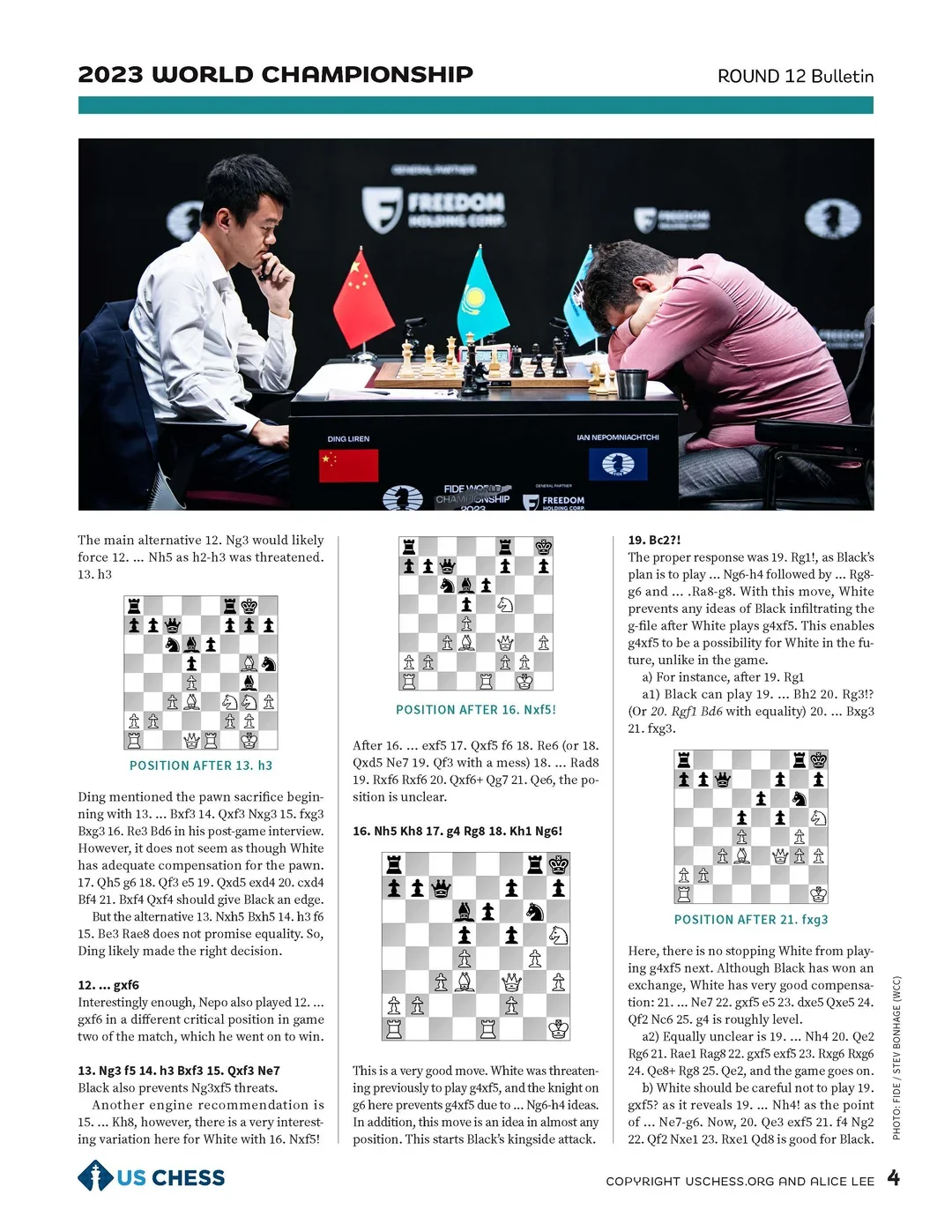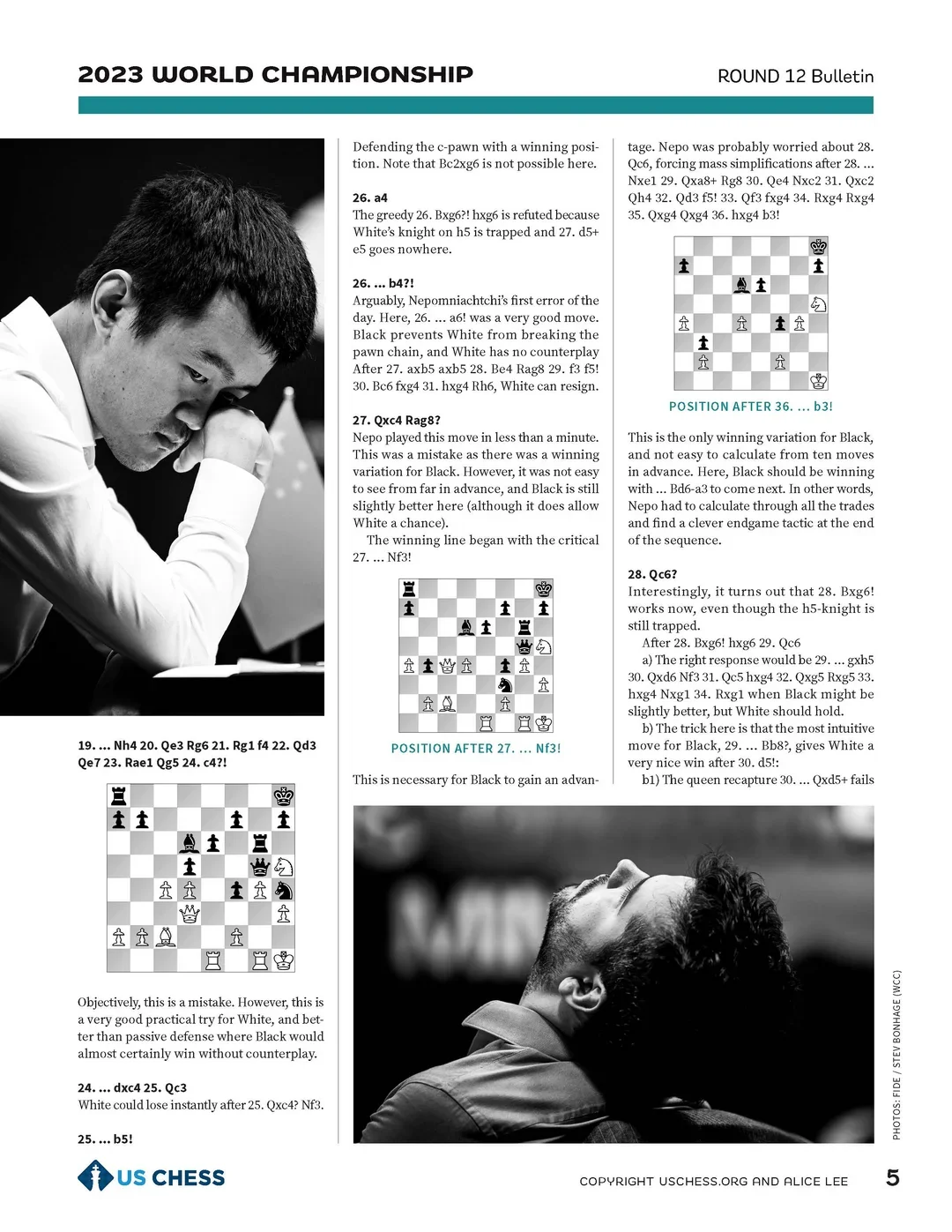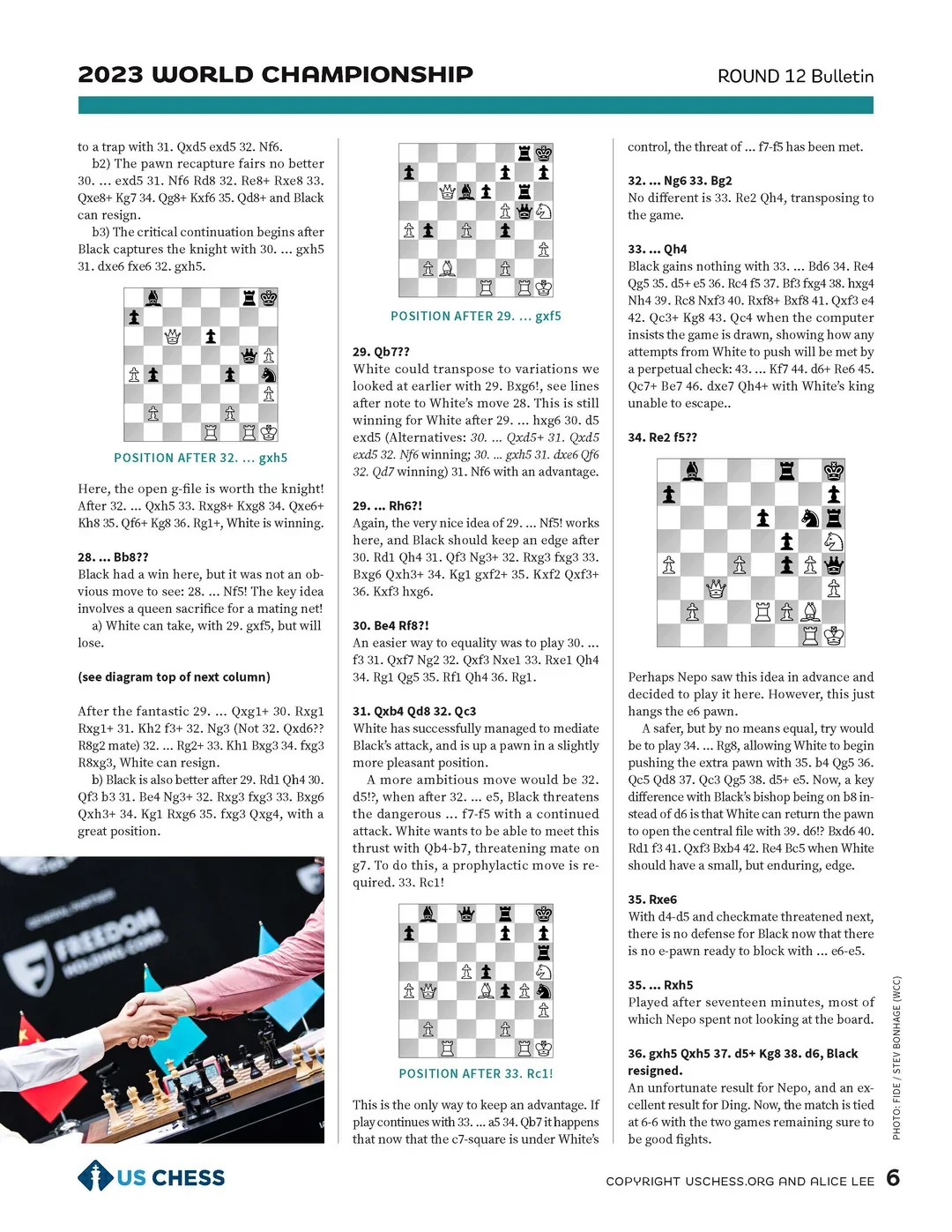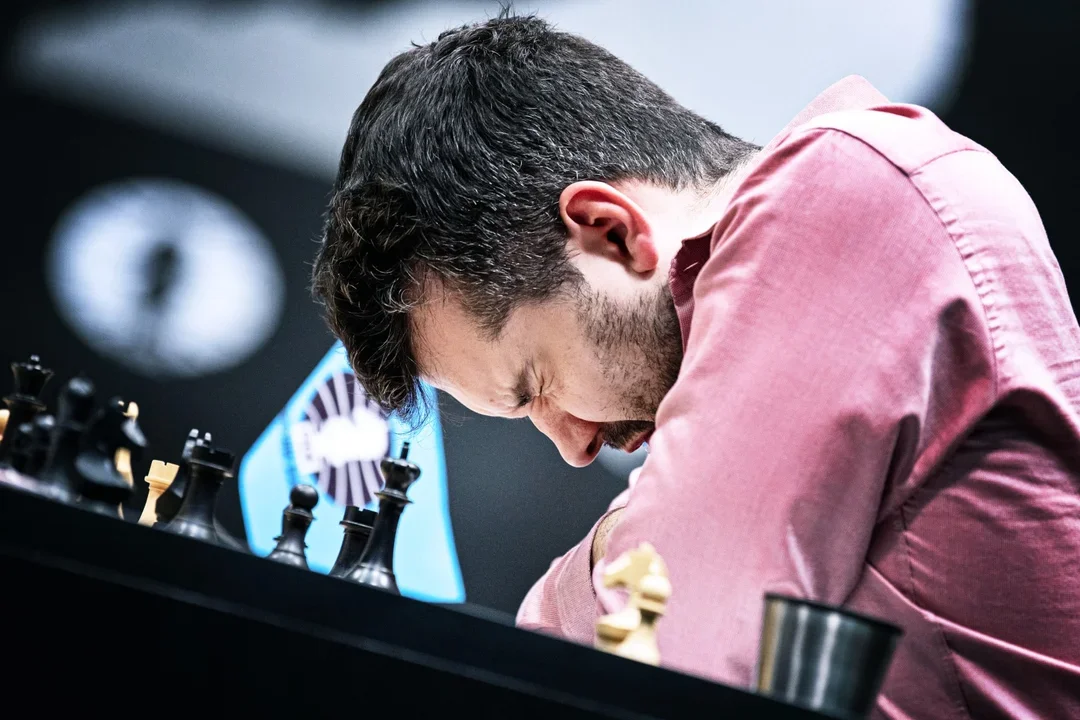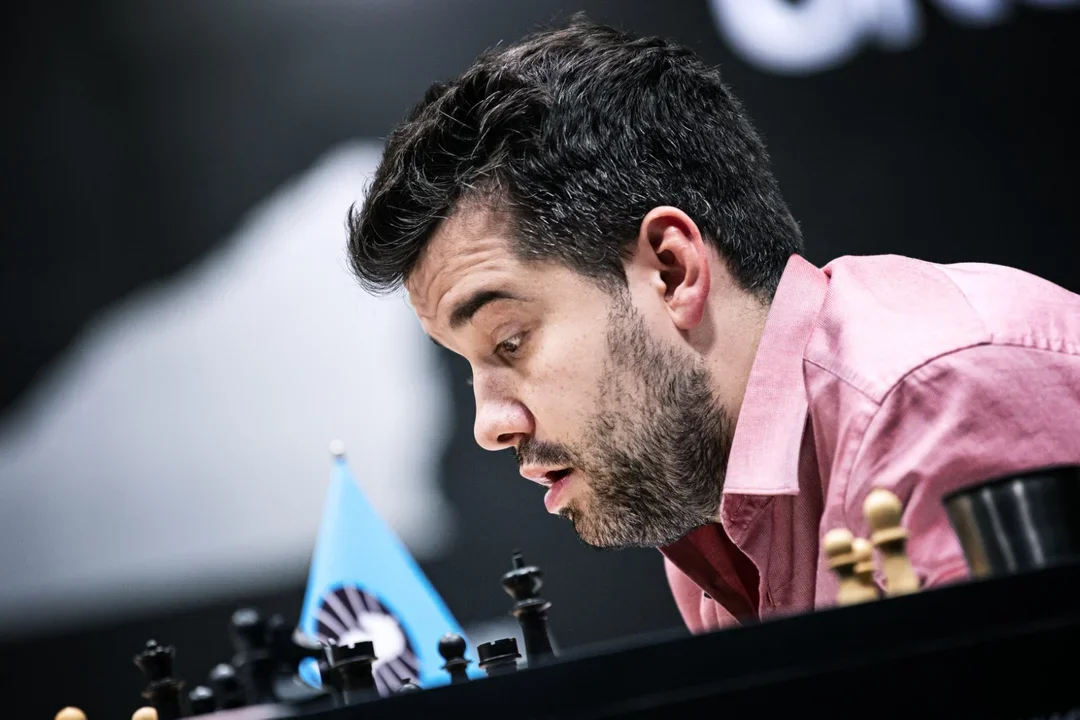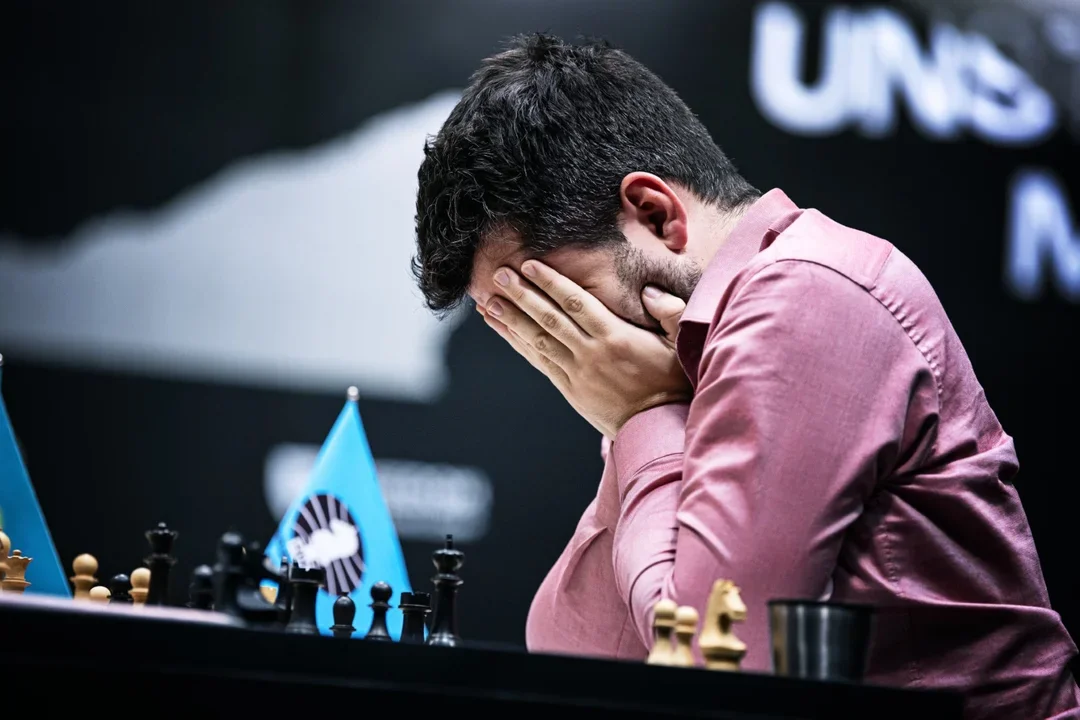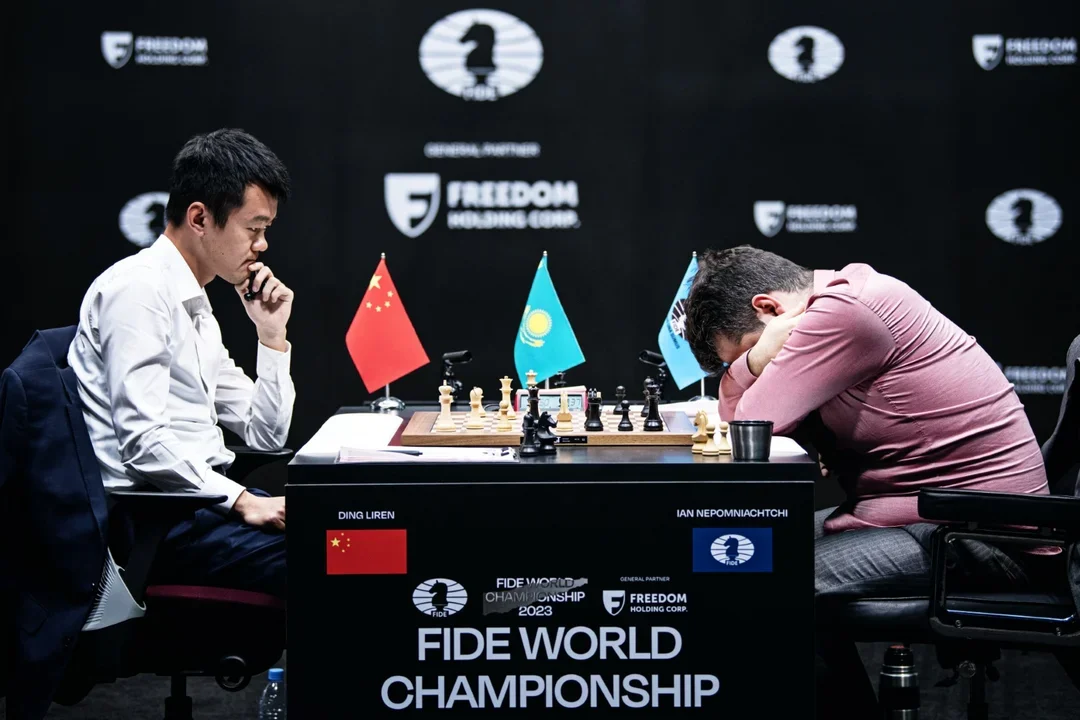
As always, you can download today's printable bulletin, or follow along with FM Alice Lee's annotations embedded below.
Around halfway through the 2023 FIDE World Chess Championship, a funny thing started to happen. Both in discussions online, and even in several drafts I edited for these bulletins, chess fans and commentators alike were referring to the sixth game as the halfway mark, even though the match was scheduled to go for 14 rounds rather than 12.
Indeed, every championship match since the unification match in 2006 between GM Vladimir Kramnik and GM Veselin Topalov has been a best-of-12. That is, until the 2021 match between GM Magnus Carlsen and GM Ian Nepomniachtchi, which Carlsen won 7½-3½ in just 11 games. The chess masses could be forgiven, then, for forgetting that the World Championship is now a best-of-14.
Until now. In a complicated, nervy, and downright chaotic twelfth game, Ding evened the score 6-6 against Nepomniachtchi, marking the first time since the 2004 Classical World Chess Championship between Kramnik and GM Peter Leko that more than 12 classical games will be needed to determine a champion.
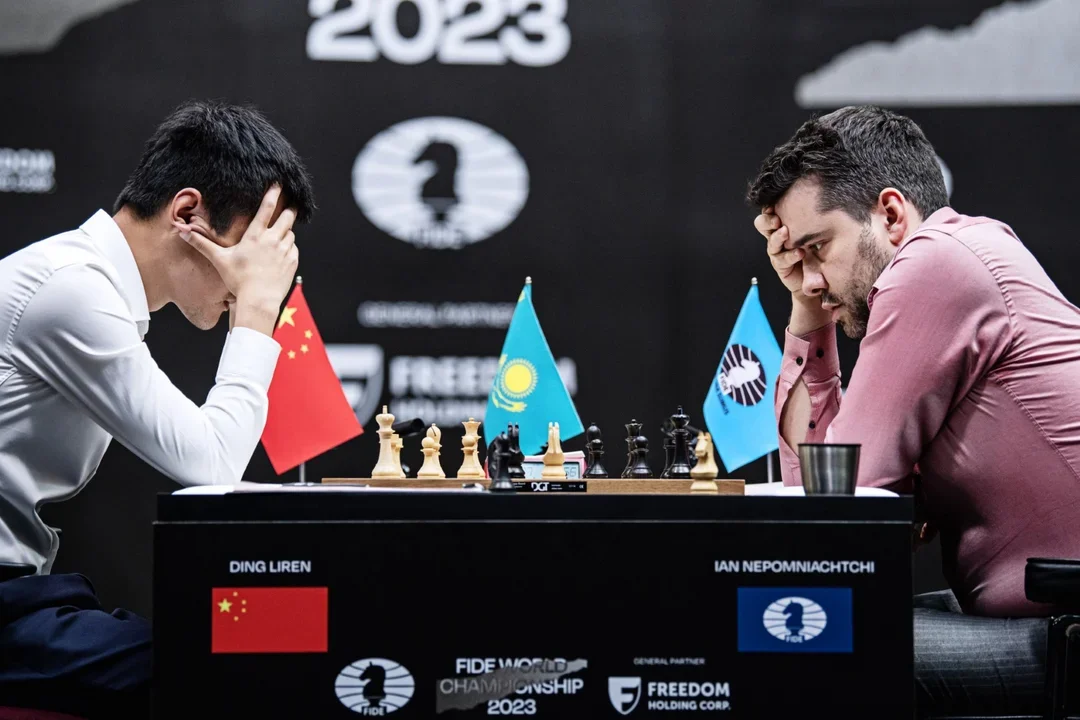
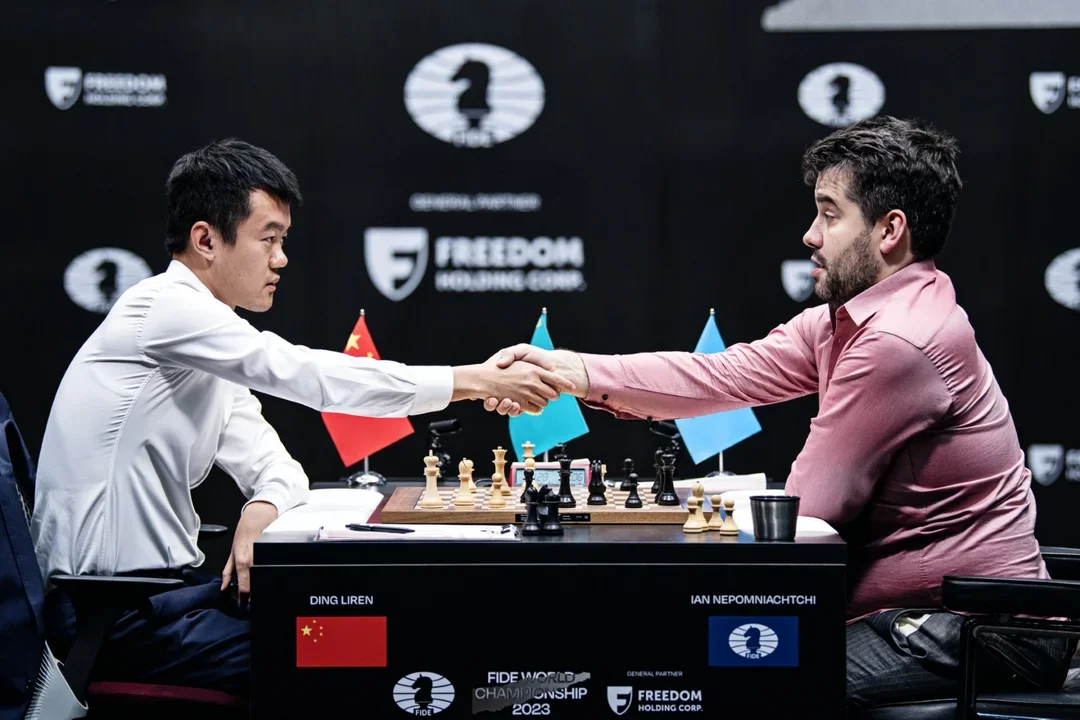
In an earlier press conference, Ding suggested the match could benefit from being even longer given how interesting the games were, which drew laughter from his opponent. But, today, both players began showing signs of fatigue and wear in what, unfortunately at times for both, was perhaps the most complex position of any game to occur in the match so far.
Out of the gate, Ding employed a familiar strategy of eschewing more popular openings in order to get an original game, this time in the Colle System beginning with 1. d4 and followed by pushing c2-c3 and placing his knights on the f3- and d2-squares. The strategy worked in the sense of preventing Nepomniachtchi from drying out the game, and in the sense of allowing Ding to take risks and play creatively.
Nepomniachtchi was up to the task, astutely maneuvering his pieces to make the most of Ding’s growing kingside weaknesses. After one inaccuracy on move 19, Nepomniachtchi’s pieces roared to life. By the time American viewers were waking up, Ding was in dire straits, creating complications and holding on by a thread in opening up the position on move 26. A loss would virtually guarantee a match victory for Nepo, who would then need to only draw one of the final two games to clinch the match.
What happened over the course of the ensuing six moves was about as tense of a fifteen minutes as a chess fan (or player) could ask for. The problems started with the fact that the 12 total moves took a total of only fifteen minutes, despite Ding still having 30 minutes and Nepomniachtchi still with 42 minutes to reach move 40. Perhaps memories of Ding’s time trouble were still fresh in both player’s minds, as Nepomniachtchi felt an urge to push Ding on the clock and Ding, in turn, felt like he had less time to calculate.
Or perhaps neither player realized at the time just how critical this position was. With Nepomniachtchi voluntarily sacrificing an Exchange, but neither king particularly safe, every move contained numerous transformations and variations with ridiculous subtlety. Nepomniachtchi let things slip away by pushing his b-pawn, but Ding gave him more chances to attack, which Nepomniachtchi then giving Ding a close-to-winning sequence. Not only did Ding miss this, but he missed a deep combination that would have given Nepomniachtchi a winning endgame after mass simplifications. Again, this all unfolded over 15 minutes.
By move 32, the dust had settled. Ding was up a pawn, and although computers were claiming Nepomniachtchi had compensation, his position was not easy to play. His time advantage began to evaporate, and by move 32 he only had 23 minutes to Ding’s 19. The players continued to slow down, taking stock of the position, as it looked like they would comfortably reach time control.

Then, Nepomniachtchi took three minutes on move 34, finally pushing his f-pawn to a threatening square that commentators had been suggesting for the past dozen turns. Ding paused for a second, captured the e-pawn that was now hanging, and Nepomniachtchi threw his hands in the air. Did he miss the hanging pawn? Did he miss that, without an e-pawn, he could not block Ding’s incoming checks?

Whatever the case, it was clear to Nepomniachtchi that his position was now completely hopeless. He sat in his chair, turned away from the board, talking to himself, in utter shock. He spent 17 of his remaining 19 minutes here, occasionally double-checking his position to see if a resource would materialize. Then he made a couple quick moves, extended his hand, and accepted that, less than two hours after being on the brink of gaining a two-game lead, Ding had officially leveled the match with only two games to play.
It is perhaps an unfair stereotype to say that young players are always more tactically alert. Nevertheless, it is good fortune that our youngest commentator of the match is providing annotations on the sharpest game we’ve seen. Without further ado, here is FM Alice Lee.
FM Alice Lee is the fifth-highest rated woman in the country and the second-highest rated 13-year-old (regardless of gender). Born and residing in Minneapolis, MN, Lee earned the WIM title in 2021 and crossed the rating threshold for FM the next year. She currently has two IM norms (out of a required three) and is just nine points shy of the rating threshold for the IM title. Some of her achievements include earning the Samford fellowship in 2022 and qualifying for the U.S. Women’s Chess Championship that same year, where she finished tied for fifth out of 14 players. She has also finished second in both the 2022 and 2023 editions of the American Cup, losing only to GM Irina Krush in the finals each year.
See all of our 2023 FIDE World Championship coverage.
See results and full schedule on the official website.
Follow our lichess profile for more studies.
Watch live commentary of each round on Chess.com and from FIDE.
Categories
Archives
- January 2026 (10)
- December 2025 (27)
- November 2025 (29)
- October 2025 (39)
- September 2025 (27)
- August 2025 (29)
- July 2025 (43)
- June 2025 (25)
- May 2025 (24)
- April 2025 (29)
- March 2025 (29)
- February 2025 (20)
- January 2025 (24)
- December 2024 (34)
- November 2024 (18)
- October 2024 (35)
- September 2024 (23)
- August 2024 (27)
- July 2024 (44)
- June 2024 (27)
- May 2024 (31)
- April 2024 (51)
- March 2024 (34)
- February 2024 (25)
- January 2024 (26)
- December 2023 (29)
- November 2023 (26)
- October 2023 (37)
- September 2023 (27)
- August 2023 (37)
- July 2023 (47)
- June 2023 (33)
- May 2023 (37)
- April 2023 (45)
- March 2023 (37)
- February 2023 (28)
- January 2023 (31)
- December 2022 (23)
- November 2022 (32)
- October 2022 (31)
- September 2022 (19)
- August 2022 (39)
- July 2022 (32)
- June 2022 (35)
- May 2022 (21)
- April 2022 (31)
- March 2022 (33)
- February 2022 (21)
- January 2022 (27)
- December 2021 (36)
- November 2021 (34)
- October 2021 (25)
- September 2021 (25)
- August 2021 (41)
- July 2021 (36)
- June 2021 (29)
- May 2021 (29)
- April 2021 (31)
- March 2021 (33)
- February 2021 (28)
- January 2021 (29)
- December 2020 (38)
- November 2020 (40)
- October 2020 (41)
- September 2020 (35)
- August 2020 (38)
- July 2020 (36)
- June 2020 (46)
- May 2020 (42)
- April 2020 (37)
- March 2020 (60)
- February 2020 (38)
- January 2020 (45)
- December 2019 (34)
- November 2019 (35)
- October 2019 (42)
- September 2019 (45)
- August 2019 (56)
- July 2019 (44)
- June 2019 (35)
- May 2019 (40)
- April 2019 (48)
- March 2019 (61)
- February 2019 (39)
- January 2019 (30)
- December 2018 (29)
- November 2018 (51)
- October 2018 (45)
- September 2018 (29)
- August 2018 (49)
- July 2018 (35)
- June 2018 (31)
- May 2018 (39)
- April 2018 (31)
- March 2018 (26)
- February 2018 (33)
- January 2018 (30)
- December 2017 (26)
- November 2017 (24)
- October 2017 (30)
- September 2017 (30)
- August 2017 (31)
- July 2017 (28)
- June 2017 (32)
- May 2017 (26)
- April 2017 (37)
- March 2017 (28)
- February 2017 (30)
- January 2017 (27)
- December 2016 (29)
- November 2016 (24)
- October 2016 (32)
- September 2016 (31)
- August 2016 (27)
- July 2016 (24)
- June 2016 (26)
- May 2016 (19)
- April 2016 (30)
- March 2016 (36)
- February 2016 (28)
- January 2016 (32)
- December 2015 (26)
- November 2015 (23)
- October 2015 (16)
- September 2015 (28)
- August 2015 (28)
- July 2015 (6)
- June 2015 (1)
- May 2015 (2)
- April 2015 (1)
- February 2015 (3)
- January 2015 (1)
- December 2014 (1)
- July 2010 (1)
- October 1991 (1)
- August 1989 (1)
- January 1988 (1)
- December 1983 (1)


